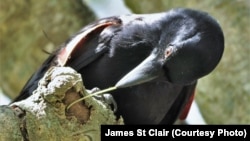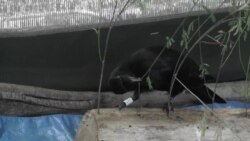Some New Caledonian crows craft hooked tools out of branched twigs, and Scottish biologists have discovered why - the birds can extract food from cracks and crevises several times faster than by using straight twigs.
"It is a painstaking sequence of behaviors,” explains Professor James St. Clair, from the University of St. Andrews, the lead author of the new study in the current issue of Nature Ecology & Evolution. “Crows seek out particular plant species, harvest a forked twig, and then, firmly holding it underfoot, carve, nibble and peel its tip, until it has a neat little hook.”
Watch a New Caledonian crow make and use a hooked tool (Credit Rutz Group)
The Scottish team conducted experiments to record how long wild-caught crows took to extract food from a range of naturalistic tasks, using either hooked or non-hooked tool designs. Depending on the task, they found that hooked tools were between two and 10 times more efficient than non-hooked tools.
Although it takes the crow a while to create the hook, getting food more quickly means it has more time and energy for reproduction and avoiding predators. The researchers do not know whether the hook-making know-how is inherited or learned by observation, but because hooked-tool users will live longer and leave more offspring, the skill is expected to spread.







